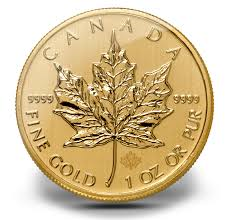
This article looks at investing in physical gold. Gold is the most popular type of bullion and it is trading well below its all-time highs of 2011.
There are 2 ways to invest in physical gold. You can either purchase certificates or other financial products that are backed by physical gold (ie. the Royal Canadian Mint’s exchange-traded receipts, SPDR Gold Trust, or GLD on the NYSE, or even iShares CGL). Or you can own the physical gold bullion itself. Given these options, I have a clear preference for owning physical gold. Here’s why.
Why Buy Physical Gold?
Some investors hold a small percentage of their assets in gold, not because it is a particularly profitable investment, but because it provides a level of diversification for their portfolios.
Gold is negatively correlated to the stock market, meaning that when stocks go down, the price of gold goes up. Gold is basically an insurance policy for a portfolio. It serves as an inflation hedge while also protecting against deflation.
If you want to invest in gold, I highly recommend owning physical gold rather than ETFs, ETRs or other financial instruments that track the precious metal.
Why? Gold serves a specific function in a portfolio and can only serve that function if you own it physically. Because gold is used as insurance, relying on paper certificates or trust units is inherently risky and problematic for 2 major reasons.
Investing in Paper Gold is Risky
First, certificates or trust units represent merely a claim on physical gold. Just because someone possesses a claim does not guarantee that they’ll get it.
There have been some legitimate concerns expressed about the number of financial products that claim to be backed by physical gold versus the actual amount of physical gold in storage.
So the first real danger in owning “paper” gold is that, since you don’t have direct control over physical gold, you many not be able to acquire any. Sure you’ll get a cash payout but that, of course, defeats the purpose of owning gold.
The second reason why owning physical gold is better than owning it through financial products is that the threshold to cash in trust units for physical gold is far beyond the reach of the average investor.
For example, in order to redeem SPDR GLD units for physical gold, you need to be “authorized” and be able to redeem 100,000 units, or nearly $12,000,000!
Another example is the Royal Canadian Mint’s Gold ETR that trades on the TSX under the ticker MNT. These units are also redeemable for physical gold but the catch is that you need a minimum of 10,000 units to do so.
At today’s price (July 26, 2014), MNT trades at $15.19, so that’s about $151,900. Again, this is simply not a practical way for the average investor to own physical gold.
For these 2 important reasons, I believe that nothing beats owning the real deal.
How to Invest in Physical Gold
Gold is traded according to its spot price in US dollars on the open market. When buying physical gold, there is a premium (no more than 5%) that covers manufacturing, storage and shipping costs.
Those looking to buy physical gold have 2 basic options: bars or coins. I personally prefer the Royal Canadian Mint coins because of their small size and their international reputation for being high quality gold.
Since 1979, the RCM has produced the world renowned gold Maple Leaf bullion coin. These are high quality coins that have a purity of 0.9999 or 99.99%. These coins were so popular with investors that the RCM began producing a silver variant of the Maple Leaf coin in 1988.
To protect against counterfeiting, in 2013, the RCM introduced a new security feature in the form of a micro engraved textured maple leaf. The silver Maple Leafs are sold in 1OZ coins only, while the gold ones are sold in 1OZ, 1/2 OZ, 1/10 OZ, 1/20 OZ, and 1/25 OZ. So these coins are well within the affordability level for the average investor.

While the RCM produces these bullion coins, they do not sell them directly to the public. You can purchase these coins at most banks, reputable coin dealers or through precious metals dealers (ie. J & M’s Bullion Coins and Bars, Kitco or Border Gold).
If you choose to own physical gold, you’ll also need a place to store it. You can either use a safe or rent a safety deposit box at your local bank branch. You’ll also want to consider purchasing insurance for your holdings.
Is Physical Gold A Good Investment?
Gold has been a safe haven for investors for centuries and is international recognized as having intrinsic value. As I mentioned above, it is also a great way to add a level of diversification to a portfolio.
The downside to owning gold is that it is not an income producing asset. Gold doesn’t pay you to own it. It can only act as a form of insurance and an inflation hedge.
Warren Buffett’s on Investing in Gold
My favorite explanation as to whether or not gold is a good investment comes from the legendary investor Warren Buffett. In Berkshire Hathaway’s 2011 Letter to Shareholders, when gold was trading at an all-time high, Buffett wrote what I believe to be the most enduring statement on gold as an investment:
[gold] is an asset that will never produce anything…If all of [the world’s] gold were melded together, it would form a cube of about 68 feet per side…[and] its value [at 2011 prices] would be $9.6 trillion…For that, we could buy all U.S. cropland (400 million acres with output of about $200 billion annually), plus 16 Exxon Mobils (the world’s most profitable company, one earning more than $40 billion annually). After these purchases, we would have about $1 trillion left over for walking around money.
A century from now the 400 million acres of farmland will have produced staggering amounts of corn, wheat, cotton, and other crops – and will continue to produce that valuable bounty, whatever the currency may be. Exxon Mobil will probably have delivered trillions of dollars in dividends to its owners and will also hold assets worth many more trillions (and, remember, you get 16 Exxons). The gold will be unchanged in size and still incapable of producing anything…I’m confident, however, that the $9.3 trillion current valuation of [the gold] will compound over the century at a rate far inferior to that achieved by [the alternative].
Should Gold Be in Your Investing Plan?
As with everything else, this question depends on what kind of investor you are. On the one hand, there’s a lot of negative sentiment on gold right now.
Many regard it as a haven for so-called doomers and gloomers who are waiting for the end of the world. These people argue that since 2009, all of the money printing, deficit spending and mounting sovereign debt levels will eventually cause a global financial collapse. Gold will then re-emerge as the backbone of a new international financial system.
On the other hand we have Buffett who take the long view and advocates for owning productive assets. He makes a strong case, especially when you factor in the compound growth that productive, income producing assets deliver.
Beyond the extreme views of the doomers and gloomers, I don’t think anyone would recommend holding a large percentage of your assets in gold. More often than not, it is said that holding a small amount of physical gold does add a level of diversification to a portfolio. So I think there can be a place for gold in a portfolio but it should never be more than 5% of your total assets.
What do you think? Does gold have a place in your portfolio?
For more information on tracking the spot price of gold and some other useful articles check out Kitco’s website.
Also check out my Youtube video on owning physical gold:
Where to Buy Gold
For our precious metals we use Silver Gold Bull because they price match and offer fast, insured, delivery.
If you’ve enjoyed this article, check out my other articles on rare coins:
Thanks for reading this post on investing in physical gold.